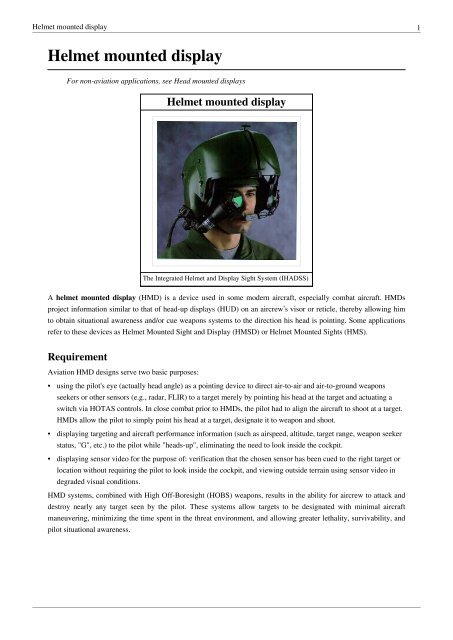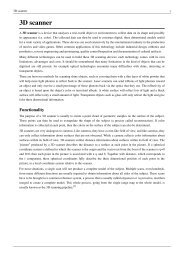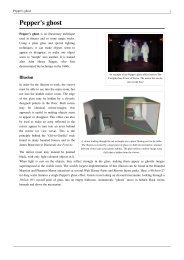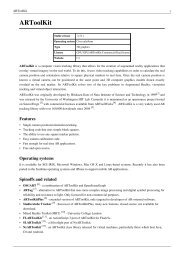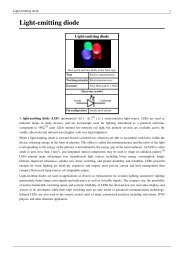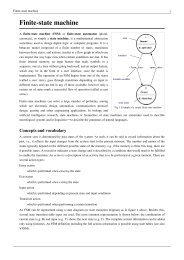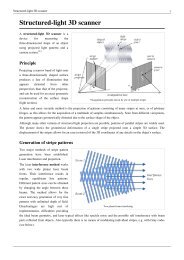Helmet mounted display - Wikipedia, the free ... - Ex-ch.com
Helmet mounted display - Wikipedia, the free ... - Ex-ch.com
Helmet mounted display - Wikipedia, the free ... - Ex-ch.com
Create successful ePaper yourself
Turn your PDF publications into a flip-book with our unique Google optimized e-Paper software.
<strong>Helmet</strong> <strong>mounted</strong> <strong>display</strong> 1<br />
<strong>Helmet</strong> <strong>mounted</strong> <strong>display</strong><br />
For non-aviation applications, see Head <strong>mounted</strong> <strong>display</strong>s<br />
<strong>Helmet</strong> <strong>mounted</strong> <strong>display</strong><br />
The Integrated <strong>Helmet</strong> and Display Sight System (IHADSS)<br />
A helmet <strong>mounted</strong> <strong>display</strong> (HMD) is a device used in some modern aircraft, especially <strong>com</strong>bat aircraft. HMDs<br />
project information similar to that of head-up <strong>display</strong>s (HUD) on an aircrew’s visor or reticle, <strong>the</strong>reby allowing him<br />
to obtain situational awareness and/or cue weapons systems to <strong>the</strong> direction his head is pointing. Some applications<br />
refer to <strong>the</strong>se devices as <strong>Helmet</strong> Mounted Sight and Display (HMSD) or <strong>Helmet</strong> Mounted Sights (HMS).<br />
Requirement<br />
Aviation HMD designs serve two basic purposes:<br />
• using <strong>the</strong> pilot's eye (actually head angle) as a pointing device to direct air-to-air and air-to-ground weapons<br />
seekers or o<strong>the</strong>r sensors (e.g., radar, FLIR) to a target merely by pointing his head at <strong>the</strong> target and actuating a<br />
swit<strong>ch</strong> via HOTAS controls. In close <strong>com</strong>bat prior to HMDs, <strong>the</strong> pilot had to align <strong>the</strong> aircraft to shoot at a target.<br />
HMDs allow <strong>the</strong> pilot to simply point his head at a target, designate it to weapon and shoot.<br />
• <strong>display</strong>ing targeting and aircraft performance information (su<strong>ch</strong> as airspeed, altitude, target range, weapon seeker<br />
status, "G", etc.) to <strong>the</strong> pilot while "heads-up", eliminating <strong>the</strong> need to look inside <strong>the</strong> cockpit.<br />
• <strong>display</strong>ing sensor video for <strong>the</strong> purpose of: verification that <strong>the</strong> <strong>ch</strong>osen sensor has been cued to <strong>the</strong> right target or<br />
location without requiring <strong>the</strong> pilot to look inside <strong>the</strong> cockpit, and viewing outside terrain using sensor video in<br />
degraded visual conditions.<br />
HMD systems, <strong>com</strong>bined with High Off-Boresight (HOBS) weapons, results in <strong>the</strong> ability for aircrew to attack and<br />
destroy nearly any target seen by <strong>the</strong> pilot. These systems allow targets to be designated with minimal aircraft<br />
maneuvering, minimizing <strong>the</strong> time spent in <strong>the</strong> threat environment, and allowing greater lethality, survivability, and<br />
pilot situational awareness.
<strong>Helmet</strong> <strong>mounted</strong> <strong>display</strong> 2<br />
History<br />
The first aircraft with simple HMD devices appeared for experimental purpose in <strong>the</strong> mid seventies to aid in<br />
targeting heat seeking missiles. These rudimentary devices were better described as <strong>Helmet</strong> Mounted Sights. Mirage<br />
F1AZ of <strong>the</strong> SAAF [South African Airforce] used a locally developed helmet <strong>mounted</strong> sight. This enables <strong>the</strong> pilot<br />
to make bore attacks, without having to manoeuvre until <strong>the</strong> optimum firing position. South Africa subsequently<br />
emerged as one of <strong>the</strong> pioneers and leaders in helmet <strong>mounted</strong> sight te<strong>ch</strong>nology. The SAAF was also <strong>the</strong> first Air<br />
Force to fly <strong>the</strong> helmet sight operationally. The US Navy's Visual Target Acquisition System (VTAS), made by<br />
Honeywell Corporation was a simple me<strong>ch</strong>anical "ring and bead" style sight fitted to <strong>the</strong> front of <strong>the</strong> pilot's helmet<br />
that was flown in <strong>the</strong> 1974-78 ACEVAL/AIMVAL on U.S. F-14 and F-15 fighters<br />
VTAS received praise for its effectiveness in targeting off-boresight missiles, but <strong>the</strong> U.S. did not pursue fielding it<br />
except for integration into late model Navy F-4 Phantoms equipped with <strong>the</strong> AIM-9 Sidewinder. [1] HMDs were also<br />
introduced in helicopters during this time.<br />
The first operational jet fighters with HMD (Mirage F1AZ) were fielded by <strong>the</strong> South African Air Force. After <strong>the</strong><br />
South African system had been proven in <strong>com</strong>bat, playing a role in downing Soviet aircraft over Angola, <strong>the</strong> Soviets<br />
embarked on a crash program to counter <strong>the</strong> te<strong>ch</strong>nology. As a result, <strong>the</strong> MiG-29 was fielded in 1985 with an HMD<br />
and a high off-boresight weapon (AA-11 Ar<strong>ch</strong>er/R-73), giving <strong>the</strong>m an advantage in close in maneuvering<br />
engagements.<br />
Several nations responded with programs to counter <strong>the</strong> MiG-29/HMD/AA-11 (and later Su-27) <strong>com</strong>bination once<br />
its effectiveness was known, principally through access to former East German MiG-29s that were operated by <strong>the</strong><br />
unified German Air Force.<br />
The first successful non-Soviet HMD was <strong>the</strong> Israeli Air Force Elbit DASH series, fielded in conjunction with <strong>the</strong><br />
Python 4, in <strong>the</strong> early 1990s. American and European fighter HMDs lagged behind, not be<strong>com</strong>ing widely used until<br />
<strong>the</strong> late 1990s and early 2000s. The US-UK-Germany responded initially with a <strong>com</strong>bined ASRAAM effort.<br />
Te<strong>ch</strong>nical difficulties led to <strong>the</strong> US abandoning ASRAAM, instead funding development of <strong>the</strong> AIM-9X and <strong>the</strong><br />
Joint <strong>Helmet</strong> Mounted Cueing System in 1990.<br />
Te<strong>ch</strong>nology<br />
While conceptually simple, implementation of aircraft HMDs is quite <strong>com</strong>plex. There are many variables: [2]<br />
• precision - <strong>the</strong> angular error between <strong>the</strong> line-of-sight and <strong>the</strong> derived cue. The position of <strong>the</strong> helmet is what is<br />
used to point <strong>the</strong> missile, it thus must be calibrated and fit securely on <strong>the</strong> pilot's head. The line between <strong>the</strong> pilot's<br />
eye and <strong>the</strong> reticle on <strong>the</strong> visor is known as <strong>the</strong> line of sight (LOS) between <strong>the</strong> aircraft and <strong>the</strong> intended target.<br />
The user's eye must stay aligned with <strong>the</strong> sight – in o<strong>the</strong>r words, current HMDs cannot sense where <strong>the</strong> eye is<br />
looking, but can place a "pipper" between <strong>the</strong> eye and <strong>the</strong> target.<br />
• latency or slew rate - how mu<strong>ch</strong> lag <strong>the</strong>re is between <strong>the</strong> helmet and <strong>the</strong> cue.<br />
• field of regard - <strong>the</strong> angular range over whi<strong>ch</strong> <strong>the</strong> sight can still produce a suitably accurate measurement.<br />
• weight and balance - total helmet weight and its center of gravity, whi<strong>ch</strong> are particularly important under high "g"<br />
maneuvers. Weight is <strong>the</strong> largest problem faced by fighter aircraft HMD designers. This is mu<strong>ch</strong> less a concern<br />
for helicopter applications, making elaborate helicopter HMDs <strong>com</strong>mon.<br />
• safety and cockpit <strong>com</strong>patibility, including ejection seat <strong>com</strong>patibility.<br />
• optical <strong>ch</strong>aracteristics – calibration, sharpness, distant focus (or 'Collimation', a te<strong>ch</strong>nique used to present <strong>the</strong><br />
images at a distant focus, whi<strong>ch</strong> improves <strong>the</strong> readability of images), monocular vs. binocular imagery, eye<br />
dominance, and binocular rivalry.<br />
• durability and ability to handle day to day wear and tear.<br />
• cost, including integration and training.
<strong>Helmet</strong> <strong>mounted</strong> <strong>display</strong> 3<br />
• fit and interfacing <strong>the</strong> aviator's head to <strong>the</strong> aircraft – head anthropometry and facial anatomy make helmet fitting a<br />
crucial factor in <strong>the</strong> aviator's ability to interface with <strong>the</strong> aircraft systems. Misalignment or helmet shift can cause<br />
an inaccurate picture.<br />
Head Position Sensing<br />
HMD designs must sense <strong>the</strong> elevation, azimuth and tilt of <strong>the</strong> pilot's head relative to <strong>the</strong> airframe with sufficient<br />
precision even under high "g" and during rapid head movement. Two basic methods are used in current HMD<br />
te<strong>ch</strong>nology - optical and electromagnetic. [2]<br />
Optical tracking<br />
Optical systems employ infrared emitters on <strong>the</strong> helmet (or cockpit) infrared detectors in <strong>the</strong> cockpit (or helmet), to<br />
measure <strong>the</strong> pilot's head position. The main limitations are restricted fields of regard and sensitivity to sunlight or<br />
[2] [2]<br />
o<strong>the</strong>r heat sources. The MiG-29/AA-11 Ar<strong>ch</strong>er system uses this te<strong>ch</strong>nology.<br />
Electromagnetic tracking<br />
Electromagnetic sensing designs use coils (in <strong>the</strong> helmet) placed in an alternating field (generated in <strong>the</strong> cockpit) to<br />
produce alternating electrical voltages based on <strong>the</strong> movement of <strong>the</strong> helmet in multiple axes. This te<strong>ch</strong>nique<br />
requires precise magnetic mapping of <strong>the</strong> cockpit to account for ferrous and conductive materials in <strong>the</strong> seat, cockpit<br />
sills and canopy to reduce angular errors in <strong>the</strong> measurement. [3]<br />
Optics<br />
Modern HMDs typically employ a <strong>com</strong>pact CRT embedded in <strong>the</strong> helmet, and suitable optics to <strong>display</strong> symbology<br />
on to <strong>the</strong> pilot's visor or reticle, focused at infinity. Advanced HMDs can also project FLIR or NVG imagery.<br />
Major Systems<br />
Systems are presented in rough <strong>ch</strong>ronological order of initial operating capability.<br />
Integrated <strong>Helmet</strong> And Display Sight System (IHADSS)<br />
In 1984, <strong>the</strong> U.S. Army fielded <strong>the</strong> AH-64 Apa<strong>ch</strong>e and with it <strong>the</strong><br />
Integrated <strong>Helmet</strong> and Display Sighting System (IHADSS), a new<br />
helmet concept in whi<strong>ch</strong> <strong>the</strong> role of <strong>the</strong> helmet was expanded to<br />
provided a visually coupled interface between <strong>the</strong> aviator and <strong>the</strong><br />
aircraft. The Honeywell M142 IHADSS is fitted with a 40° by 30°<br />
field of view, video-with-symbology monocular <strong>display</strong>. IR emitters<br />
allow a slewable IR imaging sensor, <strong>mounted</strong> on <strong>the</strong> nose of <strong>the</strong><br />
aircraft, to be slaved to <strong>the</strong> aviator’s head movements. The <strong>display</strong> also<br />
enables Nap-of-<strong>the</strong>-earth night navigation. IHADSS is also used on <strong>the</strong><br />
Italian Agusta A129 Mangusta. [4]<br />
ZSh-5 / Sh<strong>ch</strong>el-3UM<br />
The Russian designed Sh<strong>ch</strong>el-3UM HMD design is fit to <strong>the</strong> ZSh-5<br />
series helmet, and is used on <strong>the</strong> MiG-29 and Su-27 in conjunction<br />
with <strong>the</strong> AA-11 Ar<strong>ch</strong>er. The HMD/Ar<strong>ch</strong>er <strong>com</strong>bination gave <strong>the</strong><br />
IHADSS<br />
MiG-29 and Su-27 a significantly improved close <strong>com</strong>bat capability and quickly became <strong>the</strong> most widely deployed<br />
[5] [6]<br />
HMD in <strong>the</strong> world.
<strong>Helmet</strong> <strong>mounted</strong> <strong>display</strong> 4<br />
Display And Sight <strong>Helmet</strong> (DASH)<br />
The Elbit Systems DASH III was <strong>the</strong> first modern Western HMD to a<strong>ch</strong>ieve operational service. Evolution of <strong>the</strong><br />
DASH began during <strong>the</strong> mid 1980s, when <strong>the</strong> IAF issued a requirement for F-15 and F-16 aircraft. The first design<br />
entered production around 1986, and <strong>the</strong> current GEN III helmet entered production during <strong>the</strong> early to mid 1990s.<br />
The current production variant is deployed on IDF F-15, and F-16 aircraft. Additionally, it has been certified on <strong>the</strong><br />
F/A-18 and F-5. The DASH III has been exported and integrated into various legacy aircraft, including <strong>the</strong><br />
MiG-21. [7] It also forms <strong>the</strong> baseline te<strong>ch</strong>nology for <strong>the</strong> US JHMCS. [8]<br />
The DASH GEN III is a wholly embedded design, where <strong>the</strong> <strong>com</strong>plete optical and position sensing coil package is<br />
built within <strong>the</strong> helmet (ei<strong>the</strong>r USAF standard HGU-55/P or <strong>the</strong> Israeli standard HGU-22/P) using a spherical visor<br />
to provide a collimated image to <strong>the</strong> pilot. A quick-disconnect wire powers <strong>the</strong> <strong>display</strong> and carries video drive<br />
signals to <strong>the</strong> helmet's Cathode Ray Tube (CRT). DASH is closely integrated with <strong>the</strong> aircraft's weapon system, via a<br />
MIL-STD-1553B bus.<br />
Joint <strong>Helmet</strong> Mounted Cueing System (JHMCS)<br />
After <strong>the</strong> U.S. withdrawal from ASRAAM, <strong>the</strong> U.S. pursued and<br />
fielded JHMCS in conjunction with <strong>the</strong> Ray<strong>the</strong>on AIM-9X, in<br />
November 2003 with <strong>the</strong> 12th and 19th Fighter Squadrons at<br />
Elmendorf AFB, Alaska. The Navy conducted RDT&E on <strong>the</strong><br />
F/A-18C as lead platform for JHMCS, but fielded it first on <strong>the</strong> F/A-18<br />
Super Hornet E and F aircraft in 2003. The USAF is also integrating<br />
JHMCS into its F-15E and F-16 aircraft.<br />
JHMCS is a derivative of <strong>the</strong> DASH III and <strong>the</strong> Kaiser Agile Eye<br />
HMDs, and was developed by Vision Systems International (VSI), a<br />
joint venture <strong>com</strong>pany formed by Rockwell Collins, Elbit and Kaiser<br />
Electronics (Kaiser is no longer affiliated with VSI; it is now equally<br />
JHMCS<br />
owned by Rockwell Collins and Elbit's US subsidiary Elbit Systems of America). Boeing integrated <strong>the</strong> system into<br />
<strong>the</strong> F/A-18 and began low-rate initial production delivery in fiscal year 2002. JHMCS is employed in <strong>the</strong><br />
F/A-18C/D/E/F, F-15C/D/E, and F-16 Block 40/50 with a design that is 95% <strong>com</strong>mon to all platforms. [9] This may<br />
also be integrated into <strong>the</strong> system of <strong>the</strong> F-22.<br />
Unlike <strong>the</strong> DASH, whi<strong>ch</strong> is integrated into <strong>the</strong> helmet itself, JHMCS assemblies atta<strong>ch</strong> to modified HGU-55/P,<br />
HGU-56/P or HGU-68/P helmets. JHMCS employs a newer, faster digital processing package, but retains <strong>the</strong> same<br />
type of electromagnetic position sensing as <strong>the</strong> DASH. The CRT package is more capable, but remains limited to<br />
mono<strong>ch</strong>rome presentation of calligraphic symbology. JHMCS provides support for raster scanned imagery to <strong>display</strong><br />
FLIR/IRST pictures for night operations and provides collimated symbology and imagery to <strong>the</strong> pilot. The<br />
integration of <strong>the</strong> night-vision goggles with <strong>the</strong> JHMCS was a key requirement of <strong>the</strong> program.<br />
When <strong>com</strong>bined with <strong>the</strong> AIM-9X, an advanced short-range dogfight weapon that employs a Focal Plane Array<br />
seeker and a thrust vectoring tail control package, JHMCS allows effective target designation up to 80 degrees ei<strong>the</strong>r<br />
side of <strong>the</strong> aircraft's nose.
<strong>Helmet</strong> <strong>mounted</strong> <strong>display</strong> 5<br />
Aselsan AVCI<br />
Aselsan of Turkey has developed a similar system to <strong>the</strong> US made JHMCS called <strong>the</strong> AVCI <strong>Helmet</strong> Integrated<br />
Cueing System. It is envisaged that <strong>the</strong> Aselsan JHMCS will be incorporated with Turkey's F-16 CCIP<br />
modernization program. The system will also be utilized into <strong>the</strong> T-129 Turkish Attack Helicopter. [10]<br />
Topsight/TopNight<br />
The Fren<strong>ch</strong> thrust vectoring Matra MBDA MICA missile for its Rafale and late model Mirage 2000 fighters was<br />
ac<strong>com</strong>panied by <strong>the</strong> Topsight HMD by Sextant Avionique. TopSight provides a 20 degree FoV for <strong>the</strong> pilot's right<br />
eye, and calligraphic symbology generated from target and aircraft parameters. Electromagnetic position sensing is<br />
employed. The Topsight helmet uses an integral embedded design, and its contoured shape is designed to provide <strong>the</strong><br />
pilot with a wholly unobstructed field of view.<br />
TopNight, a Topsight derivative, is designed specifically for adverse wea<strong>the</strong>r and night air to ground operations,<br />
employing more <strong>com</strong>plex optics to project infrared imagery overlaid with symbology.<br />
Eurofighter <strong>Helmet</strong> Mounted Symbology System<br />
The Eurofighter Typhoon utilizes <strong>the</strong> <strong>Helmet</strong> Mounted Symbology System (HMSS) developed by BAE Systems and<br />
Pilkington Optronics. It is capable of <strong>display</strong>ing both raster imagery and calligraphic symbology, with provisions for<br />
embedded NVGs. As with <strong>the</strong> DASH helmet, <strong>the</strong> system employs integrated position sensing to ensure that symbols<br />
representing outside-world entities move in line with <strong>the</strong> pilot's head movements.<br />
<strong>Helmet</strong> Mounted Display System<br />
Vision Systems International (VSI; <strong>the</strong> Elbit Systems/Rockwell Collins<br />
joint venture) along with <strong>Helmet</strong> Integrated Systems, Ltd. developed<br />
<strong>the</strong> <strong>Helmet</strong> Mounted Display System (HMDS) for <strong>the</strong> F-35 Joint Strike<br />
Fighter aircraft. In addition to standard HMD capabilities offered by<br />
o<strong>the</strong>r systems, HMDS fully utilizes <strong>the</strong> advanced avionics ar<strong>ch</strong>itecture<br />
of <strong>the</strong> F-35 and provides <strong>the</strong> pilot video with imagery in day or night<br />
conditions. As a result, <strong>the</strong> F-35 is <strong>the</strong> first tactical fighter jet in 50<br />
[11] [12]<br />
years to fly without a HUD.<br />
JedEyes TM<br />
JedEyes TM is a new system recently introduced by Elbit Systems<br />
especially to meet Apa<strong>ch</strong>e and o<strong>the</strong>r rotary wing platform<br />
requirements. The system is designed for day, night and brownout<br />
flight environments. JedEyes TM has a 70 x 40 degree FOV and<br />
2250x1200 pixels resolution.<br />
<strong>Helmet</strong>-Mounted Display System for <strong>the</strong> F-35<br />
Joint Strike Fighter
<strong>Helmet</strong> <strong>mounted</strong> <strong>display</strong> 6<br />
Cobra<br />
Sweden’s JAS 39 Gripen fighter utilizes <strong>the</strong> Cobra HMD, developed by BAE Systems, Denel Optronics of South<br />
Africa, and Saab. It has been exported to <strong>the</strong> South African Air Force. [13]<br />
Future te<strong>ch</strong>nology<br />
• VSI is developing <strong>the</strong> QuadEyeTM Night Vision Cueing & Display (NVCD) for <strong>the</strong> US Navy and US Air Force,<br />
and is also producing <strong>the</strong> DASH Generation IV HMD.<br />
• Eye tracking – Eye trackers measure <strong>the</strong> point of gaze relative to <strong>the</strong> direction of <strong>the</strong> head, allowing a <strong>com</strong>puter to<br />
sense where <strong>the</strong> user is looking. These systems are not currently used in aircraft.<br />
• Direct retinal projection – Systems that project information directly onto <strong>the</strong> wearer’s retina with a low-powered<br />
[14] [15]<br />
laser (virtual retinal <strong>display</strong>) are also in experimentation.<br />
See also<br />
• Virtual Reality (VR)<br />
• Virtual retinal <strong>display</strong><br />
• VRML<br />
• Head-up <strong>display</strong> (HUD)<br />
References<br />
[1] "VTAS helmet" (http:/ / www. best-of-flightgear. dk/ vtas. htm). Best-of-flightgear.dk. . Retrieved 2010-08-20.<br />
[2] <strong>Helmet</strong> Displays In Aviation - Contents (http:/ / www. usaarl. army. mil/ hmdbook/ cp_0002_contents. htm)<br />
[3] Air Power Australia. "<strong>Helmet</strong> Mounted Sights and Displays" (http:/ / www. ausairpower. net/ hmd-te<strong>ch</strong>nology. html). Ausairpower.net. .<br />
Retrieved 2010-08-20.<br />
[4] "The Impact of <strong>the</strong> U.S. Army's AH-64 <strong>Helmet</strong> Mounted Display on Future Aviation <strong>Helmet</strong> Design" (http:/ / stinet. dtic. mil/ oai/<br />
oai?verb=getRecord& metadataPrefix=html& identifier=ADA202984). Stinet.dtic.mil. . Retrieved 2010-08-20.<br />
[5] "Fact Sheets : Mikoyan-Gurevi<strong>ch</strong> MiG-29A : Mikoyan-Gurevi<strong>ch</strong> MiG-29A" (http:/ / www. nationalmuseum. af. mil/ factsheets/ factsheet.<br />
asp?id=8672). Nationalmuseum.af.mil. 1977-10-06. . Retrieved 2010-08-20.<br />
[6] "Fighter Aircraft, MiG-29/1" (http:/ / www. sci. fi/ ~fta/ MiG-29. htm). Sci.fi. . Retrieved 2010-08-20.<br />
[7] "MiG-21 2000 Fighter Ground Attack Air Force Te<strong>ch</strong>nology" (http:/ / www. airforce-te<strong>ch</strong>nology. <strong>com</strong>/ projects/ mig21/ ).<br />
Airforce-te<strong>ch</strong>nology.<strong>com</strong>. 1995-05-24. . Retrieved 2010-08-20.<br />
[8] "Vision Systems International - DASH" (http:/ / www. vsi-hmcs. <strong>com</strong>/ dash. htm). Vsi-hmcs.<strong>com</strong>. . Retrieved 2010-08-20.<br />
[9] "Vision Systems International - JHMCS" (http:/ / www. vsi-hmcs. <strong>com</strong>/ jhmcs. htm). Vsi-hmcs.<strong>com</strong>. . Retrieved 2010-08-20.<br />
[10] "Mon<strong>ch</strong> Yayıncılık - AVCI" (http:/ / www. mon<strong>ch</strong>. <strong>com</strong>. tr/ index. php?id=114& option=<strong>com</strong>_content& task=view). Mon<strong>ch</strong>.<strong>com</strong>.tr. .<br />
Retrieved 2010-08-20.<br />
[11] (ref: http:/ / www. rockwellcollins. <strong>com</strong>/ news/ page8813. html)<br />
[12] F-35 Joint Strike Fighter Program. "> F-35 > Te<strong>ch</strong>nology" (http:/ / www. jsf. mil/ f35/ f35_te<strong>ch</strong>nology. htm). JSF.mil. . Retrieved<br />
2010-08-20.<br />
[13] www.gripen.<strong>com</strong><br />
[14] "Virtual Retinal Display (VRD) Te<strong>ch</strong>nology." Virtual Retinal Display Te<strong>ch</strong>nology. Naval Postgraduate S<strong>ch</strong>ool. 13 February 2007 (http:/ /<br />
www. cs. nps. navy. mil/ people/ faculty/ capps/ 4473/ projects/ fiambolis/ vrd/ vrd_full. html).<br />
[15] Lake, Matt. "How It Works: Retinal Displays Add a Second Data Layer." New York Times 26 April 2001. 13 February 2006 (http:/ / www.<br />
nytimes. <strong>com</strong>/ 2001/ 04/ 26/ te<strong>ch</strong>nology/ 26HOWW. html). (registration required)
<strong>Helmet</strong> <strong>mounted</strong> <strong>display</strong> 7<br />
Bibliography<br />
• Head Mounted Displays: Designing for <strong>the</strong> user; Melzer and Moffitt; McGraw Hill, 1997<br />
<strong>Ex</strong>ternal links<br />
• Sortable <strong>com</strong>parison <strong>ch</strong>arts for a wide range of HMDs (http:/ / www. inition. co. uk/ inition/ <strong>com</strong>pare.<br />
php?SubCatID=16)<br />
• HMD/headset/VR-helmet Comparison Chart (http:/ / www. stereo3d. <strong>com</strong>/ hmd. htm)<br />
• User survey of HMD requirements (http:/ / www. sensics. <strong>com</strong>/ files/ documents/ 2008SurveyResults. pdf)<br />
• Wearable Displays (http:/ / www. dmoz. org/ Computers/ Hardware/ Peripherals/ Displays/ Wearable/ ) at <strong>the</strong><br />
Open Directory Project<br />
• Resolution analysis for HMD helmets / Comparison Chart (http:/ / vresources. org/ articles/ vre_articles/<br />
analyhmd/ analysis. htm)<br />
• Boeing description (http:/ / www. boeing. <strong>com</strong>/ defense-space/ military/ jhmcs/ index. html)<br />
• Vision Systems International (http:/ / www. vsi-hmcs. <strong>com</strong>/ index. htm)
Article Sources and Contributors 8<br />
Article Sources and Contributors<br />
<strong>Helmet</strong> <strong>mounted</strong> <strong>display</strong> Source: http://en.wikipedia.org/w/index.php?oldid=397301245 Contributors: AadaamS, Aldis90, BilCat, Chase me ladies, I'm <strong>the</strong> Cavalry, CommonsDelinker, E2a2j,<br />
Fnlayson, Gilisa, HDP, Imre.fitos, James R. Ward, Jll, KGyST, LilHelpa, Madog0on, Maverick9711, Mrg3105, Nick-D, Noameshel, Nono64, Patrick, RHaworth, Robertatac, Rror,<br />
TaintedMustard, Tallungs, Tec15, Te<strong>ch</strong>nopat, Timrollpickering, Toussaint, Vegaswikian, Welsh, Windharp, Wittlessgenstein, YUL89YYZ, 31 anonymous edits<br />
Image Sources, Licenses and Contributors<br />
Image:Integrated <strong>Helmet</strong> Display Sight System.jpg Source: http://en.wikipedia.org/w/index.php?title=File:Integrated_<strong>Helmet</strong>_Display_Sight_System.jpg License: Public Domain<br />
Contributors: e2a2j<br />
Image:Integrated <strong>Helmet</strong> and Display Sighting System.jpg Source: http://en.wikipedia.org/w/index.php?title=File:Integrated_<strong>Helmet</strong>_and_Display_Sighting_System.jpg License: Public<br />
Domain Contributors: e2a2j<br />
Image:Joint <strong>Helmet</strong> Mounted Cueing System.jpg Source: http://en.wikipedia.org/w/index.php?title=File:Joint_<strong>Helmet</strong>_Mounted_Cueing_System.jpg License: Public Domain Contributors:<br />
e2a2j<br />
File:F-35 <strong>Helmet</strong> Mounted Display System.jpg Source: http://en.wikipedia.org/w/index.php?title=File:F-35_<strong>Helmet</strong>_Mounted_Display_System.jpg License: Public Domain Contributors:<br />
USMC employee<br />
License<br />
Creative Commons Attribution-Share Alike 3.0 Unported<br />
http:/ / creative<strong>com</strong>mons. org/ licenses/ by-sa/ 3. 0/


